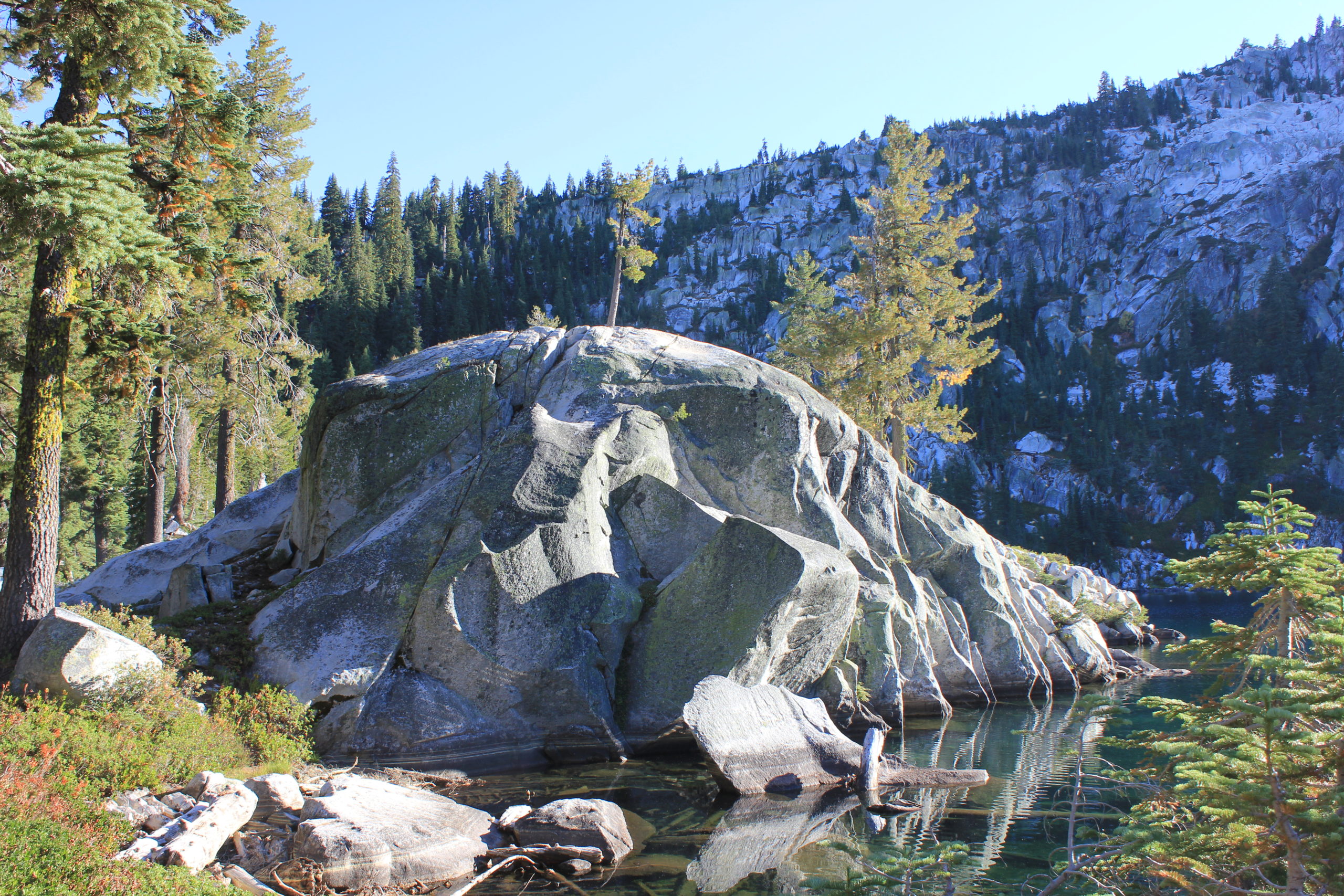“I owe the best of myself to geology, but everything it has taught me
tends to turn me away from dead things.”
— Pierre Teilhard de Chardin
Let There Be Rock
Everywhere is a landscape sculpted from rock by wind and water. When the light is right, it looks like chiseled marble on a huge scale. I look at this modest rock before me: a typical chunk of white granite that broke off of some larger rock that slid down the slope some unknown years before, and came to rest on a rock ledge. There is no friction or gravity working on it anymore, just rain, wind, and the occasional nudge from contracting and expanding with the seasons.
This rock has existed for about 35,000 millennia. I have existed for a mere 35 years. I am surrounded by cold physical structures that we warm, temporary constructs like to call “inanimate,” but is animation a prerequisite for knowledge? What can these rocks teach me after existing for so many thousands and millions of years? They can teach me patience. I can learn peace from their silent, motionless calm. They can instruct me in the acceptance of letting go, and that all things released are returned. From them I can measure the time it takes to learn – by the molecules that are flaked off by collisions with water or sand blown by the wind.
I look long and hard at this rock, trying to understand. It looks heavier than I could lift, but I try it anyway. Straining with all my energy channeled through the biological muscles and tendons that might leverage this heavy object from the grip of gravity, I intend to roll it off the ledge. I feel it shift and grind on its granite base, but no more. It will likely remain here for millennia more, due to my lack of strength. All around the rock are minute particles that have ground down to a fine dust. In one crack under the shade of the rock, a small succulent plant has taken root in the meager soil. This granite chunk, this coldly physical manifestation of creation, is fully present on a scale of existence that is incomprehensible to me, who lives and dies warmly in the time it takes for a few grains of sand to flake off its edge.
Every stone around me has been on this earth for the equivalent of thousands of human lives. The physical molecules of rocks have been here since the birth of our world. They are the foundational emissaries of the material universe. Should we be surprised if they have accumulated more wisdom than we have? Or that they possess awareness in a way we do not have the permanence to understand? Surely we observe all kinds of sentient beings learning more as they grow older and become wiser. The mountains, collectively, must know more than all of the human thoughts since the dawn of time. Human awareness in the grand design is the equivalent of but one grain of sand at the base of this rock.
We fashion grandiose scientific schema and theories like quantum mechanics to try and explain the physical universe around us, but as our ability to see and measure increases with technology, our understanding of the fundamental principle decreases. Oh sure, we’re always learning how to better classify the molecules, smash the subatomic particles together and analyze the pieces, and measure ever-smaller bits of matter as our instruments get more sophisticated. However, the most essential question: what is matter? is still unanswered. Ask the physicists to explain the behavior of the basic building blocks of our material world, for example, and their eyes will glaze over slightly as they intone the scientific litany that leads to pure mysticism. Ultimately they confide to us, as if revealing a great secret, that subatomic particles continuously appear from, and return to, a “field of potential.”
Oooohh!
Well, what does this mean? A “field of potential” implies that there are realizations to be made. As Gary Zukav pointed out in The Dancing Wu Li Masters, the astonishing thing about subatomic particles is that they appear to be making conscious decisions, all the time. By its nature, a decision is not random. Are these decisions of free will or of protocol? Both have rather profound implications. At any rate, the choices are made too frequently to measure or comprehend. The decisions themselves are the agents of creative power. If all subatomic particles are directing the unfolding of the universe, and we are composed of the same particles as rocks, then rocks must also have creative thoughts as we do; albeit on a different scale of “time” (as we know it). Isn’t it comforting to consider that rocks could have all these thoughts without so many damn distractions?
I am amazed that the physical forms of mountains have lasted for so long (as we measure time), since their numberless subatomic particles are ceaselessly coming and going. I am astonished beyond comprehension to consider that the molecules that have formed these structures for millennia are not permanent, but are constantly exchanging electron partners in an ephemeral square-dance of matter. How do they rearrange themselves exactly, every time? What awesome intelligence is capable of the intricacy and discipline required to manage a million trillion decisions per nanosecond? How do our senses recognize the shifting patterns of matter as “permanent” if they are dissolving and reappearing before our eyes? Is it merely because our optic tools are vibrating on the same wavelength, due to being composed of the same subatomic particles? Are we creating our own material universe? Is this the central delusion of existence that the Hindus call maya?
As usual, there are more questions than answers in the human mind. A rock just knows.
“The astounding discovery waiting for newcomers to physics is that the evidence gathered in the development of quantum mechanics indicates that subatomic “particles” constantly appear to be making decisions! More than that, the decisions they seem to make are based on decisions made elsewhere. Subatomic particles seem to know instantaneously what decisions are made elsewhere,
and elsewhere can be as far away as another galaxy!”
— Gary Zukav, The Dancing Wu Li Masters

